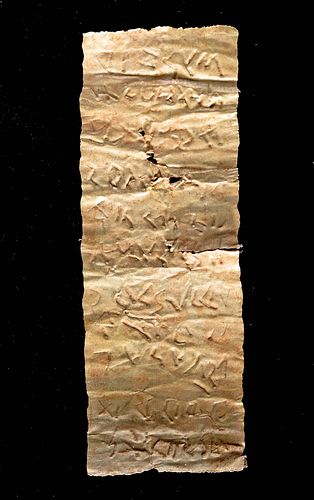Delicate Roman Gold Sheet Tablet, Inscribed in Greek
Lot 48a
About Seller
Artemis Fine Arts
686 S Taylor Ave, Ste 106
Louisville, CO 80027
United States
Selling antiquities, ancient and ethnographic art online since 1993, Artemis Gallery specializes in Classical Antiquities (Egyptian, Greek, Roman, Near Eastern), Asian, Pre-Columbian, African / Tribal / Oceanographic art. Our extensive inventory includes pottery, stone, metal, wood, glass and textil...Read more
Estimate:
$1,400 - $2,100
Absentee vs Live bid
Two ways to bid:
- Leave a max absentee bid and the platform will bid on your behalf up to your maximum bid during the live auction.
- Bid live during the auction and your bids will be submitted real-time to the auctioneer.
Bid Increments
| Price | Bid Increment |
|---|---|
| $0 | $25 |
| $300 | $50 |
| $1,000 | $100 |
| $2,000 | $250 |
| $5,000 | $500 |
| $10,000 | $1,000 |
| $20,000 | $2,500 |
| $50,000 | $5,000 |
| $100,000 | $10,000 |
| $200,000 | $20,000 |
About Auction
By Artemis Fine Arts
Mar 24, 2022
Set Reminder
2022-03-24 10:00:00
2022-03-24 10:00:00
America/New_York
Bidsquare
Bidsquare : Exceptional Antiquities Ethnographic Fine Art
https://www.bidsquare.com/auctions/artemis-gallery/exceptional-antiquities-ethnographic-fine-art-9057
Museum-worthy examples of classical antiquities (Egyptian, Greek, Roman, Near Eastern), Viking, Far East / Asian, Pre-Columbian, African / Tribal, Oceanic, Native American, Spanish Colonial, Fossils, Ancient Jewelry, Fine / Visual Arts, so much more! Artemis Fine Arts info@artemisgallery.com
Museum-worthy examples of classical antiquities (Egyptian, Greek, Roman, Near Eastern), Viking, Far East / Asian, Pre-Columbian, African / Tribal, Oceanic, Native American, Spanish Colonial, Fossils, Ancient Jewelry, Fine / Visual Arts, so much more! Artemis Fine Arts info@artemisgallery.com
- Lot Description
Roman, early Imperial Period, ca. 1st century CE. A lovely and petite sheet tablet, formed from 73% gold (equivalent to 15K+), that contains a short Greek inscription. The rectangular tablet is of an incredibly delicate form, and numerous creasing folds indicate how this tablet - perhaps along with several others - was rolled up into a tight coil before being deposited at a temple or a personal shrine. The surfaces are inscribed with 11 lines of Greek text that, while untranslated, perhaps provide an anathematic incantation upon one's name for untruths spoken or misdeeds performed. Size (tablet): 2.05" L x 0.75" W (5.2 cm x 1.9 cm); (case): 7" W x 7" H (17.8 cm x 17.8 cm); gold quality: 73% (equivalent to 15K+); weight: 0.7 grams
Cf. M. Reuter and M. Scholz. "Alles Geritzt: Botschaffen aus der Antike." Munich, 2005, no. 76
Cf. Kotansky, Roy. "Greek Magical Amulets: The Inscribed Gold, Silver, Copper, and Bronze Lamellae, Part I: Published Texts of Known Provenance." Papyrologica Coloniensia 22/1. Opladen: Westdeutscher Verlag, 1994.
Provenance: private Claremont, New Hampshire, USA collection; ex-Royal-Athena Gallery, New York, New York, USA; ex-private German collection, from the Munich Art Market, 2006
All items legal to buy/sell under U.S. Statute covering cultural patrimony Code 2600, CHAPTER 14, and are guaranteed to be as described or your money back.
A Certificate of Authenticity will accompany all winning bids.
PLEASE NOTE: Due to recent increases of shipments being seized by Australian & German customs (even for items with pre-UNESCO provenance), we will no longer ship most antiquities and ancient Chinese art to Australia & Germany. For categories of items that are acceptable to ship to Australia or Germany, please contact us directly or work with your local customs brokerage firm.
Display stands not described as included/custom in the item description are for photography purposes only and will not be included with the item upon shipping.
#170692A few small perforations along interior section, with a couple of stable fissures along peripheries, and softening to some Greek characters. Great patina throughout. Greek characters are somewhat faded and difficult to read.Condition
- Shipping Info
-
All shipping is handled in-house for your convenience. Your invoice from Artemis Gallery will include shipping calculation instructions. If in doubt, please inquire BEFORE bidding for estimated shipping costs for individual items.
-
- Buyer's Premium



 EUR
EUR CAD
CAD AUD
AUD GBP
GBP MXN
MXN HKD
HKD CNY
CNY MYR
MYR SEK
SEK SGD
SGD CHF
CHF THB
THB












